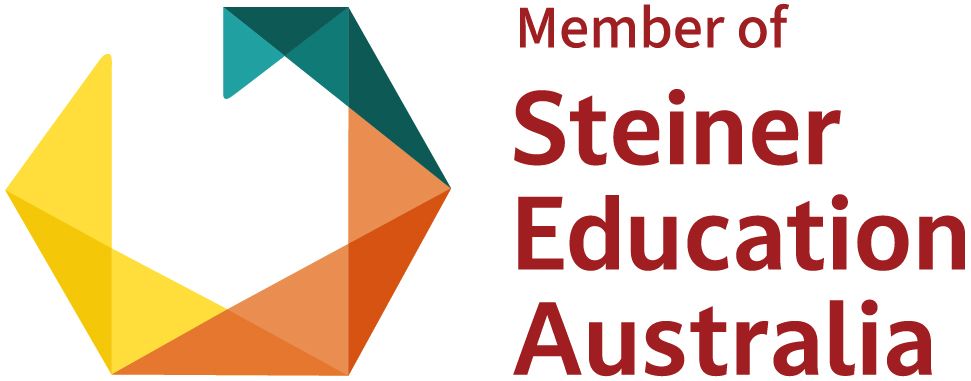ABN: 55 173 177 370
Life as Change –
The Curriculum Journey
By Vanessa Fountain
As teachers we have the privilege and honour to bear witness to the changes that occur for our students over days, weeks, and years. We see them moving through the curriculum and see how beautifully it supports their developmental needs and growth, acknowledges humanity’s journey thus far and gives our children the skills needed to navigate the future.
This journey of discovery is one that allows the student to learn about man’s journey through time, to see our heritage, to know that the world is fundamentally good, beautiful, and true and to allow us to feel our connection to the world of nature, of man and spirit.
The Waldorf /Steiner Curriculum brings to the child the content needed in a way that shows a deep understanding of the need to support not only the thinking realm but also the feeling and willing realms.
It meets the experiences of the child with the corresponding development in humanity’s history. The Class 3 curriculum is one of the Old Testament amongst other key main lessons, not from a religious point of view but from the point of view of the richness of stories offered. There are many stories that illuminate the experience of the nine-year-old child. An example is the story of Adam and Eve and the fall from Paradise. Simply, Adam and Eve want forbidden things and to challenge authority. In eating the forbidden fruit, they are overcome with shame and loss and surprised by the consequences. This is a beautiful picture of the nine-year-old child. Their job is to discover, to challenge and to realise their “nakedness”, their separateness from the parental and spiritual garden of Eden.
The curriculum also supports the parents with stories to help understand what the child is experiencing.
For example, when the child turns nine or close to this age there is a development where the child understands that certain things are no longer true, that parents are fallible and the veil of childhood in a certain way dissolves for them. It is at this time that the teacher may share the picture of the crossing of the Rubicon. The story tells of Julius Caesar crossing the Rubicon River, an act of war at the time. Once Julius crosses the river there is no return. It is an act that will set in motion consequences that are irreversible. Like knowing something, you can’t unknow it. So it is for the child, once they step into middle childhood, the mystery and wonder of early childhood cannot be revisited, at least not in the same way.
It is important to both stories that the fall and the crossing are necessary occurrences in the cycle of growth and change and to the next stage of development.
Throughout these privileged relationships between families and teachers we witness the cycles of change that families experience and the versions and permutations that those changes may take. We see parents and children move through periods of equilibrium and disequilibrium. The children through periods of mastery - calm, joy, and contentment to periods of developmental exploration, frustration, anger, fear, and uncertainty. Its good to remember that these periods are a part of a cycle, a cycle that will continue from birth to death and perhaps beyond.
There is reassurance in recognising that we are just in a part of the cycle of life and that there are strategies to assist our children without robbing them of the experience that will help them to gain resilience, strength, and compassion.
I am always reminded of the beautiful story of the caterpillar. We call him Twig in Kindy. Twig was going about life as a caterpillar doing all the things that caterpillars should. He ate, and he ate, and he was careful not to become the meal of hungry birds. All was well in Twig's world until he started having dreams and daydreams that he could fly. He knew this was not possible but told his dream to Mother Nature. The dear old dame told him that perhaps his dreams could somehow be true, but he would first need to know the secret of life. Elated, Twig went and told his friends “You may not know but soon I shall be able to fly”. The friends in turn scoffed and laughed at him. Disheartened Twig returned to his home.
He tried to be patient and let the wisdom come. As he waited, he became really still and noticed, perhaps for the first time the world around him. The sky, he noticed, was so blue, the green of the leaves and plants astonishingly beautiful and the flowers, well Twig's heart just sang. “The world is so beautiful he thought, I am happy just as I am”. Soon after Twig began to feel sleepy, he created a beautiful cocoon, snuggled inside and well, the rest is history.
The thing is, we are all like Twig. We have periods of mastery and periods of disequilibrium where we are ready to extend, to expand to develop the concept or idea of who and what we are and are capable of.
As adults we just get better at smoothing the transitions. Except of course when we don’t. Again, Twig’s story can be helpful. You see when the caterpillar goes into the cocoon, it sheds its skin. The skin becomes the hard crusty protective inner of the cocoon. The caterpillar doesn’t then “just” turn into a butterfly. It goes through a process of dissolving all that has been into what Martha Beck so beautifully calls “undifferentiated goop”. Within this goop which repeatedly builds up only to dissolve into the “no thing/ the egoless/the identity less” is the seed/idea/spiritual blueprint of a butterfly. It is not until late in the process that the imago cells of the butterfly begin the process of building the new version of self, the butterfly. When the butterfly is finally ready to emerge, it must saw the cocoon open and struggle to get out.
The act of removing itself from the cocoon is difficult and dangerous but it is in this struggle to claim the new version of the self that it finds its strength, resilience and interestingly, its longevity.
Story, like a roadmap or a curriculum can help us to move through change with more ease and surety. Change invites us to prepare (sometimes that’s just being, or in Twig’s case, by eating lots of leaves). It asks us to make a space, a place, a sanctuary/ a cocoon where we can go and find stillness, where we can hear the whisperings of the soul, our dharma, our life purpose, the next step. Change asks us to surrender who we were, to become who we are yet to be, dissolving the ego into undifferentiated goop. And then, finally, change asks us to fight for the new version of ourselves, to know that it might be uncomfortable, even difficult but that like the Rubicon or the caterpillar, once you’ve shed your skin or crossed the river, there is no turning back.
Our children need to know that we as the adults have faith in their journey and our ability to stay with them through the uncomfortable, tricky (read, “what happened to my child/angel?”) bits.
Our curriculum takes us; the children, the parents and the teachers by the hand and leads us through change, inviting us to become the soul’s whispering we know we were born to be. Sometimes change/transformation is uncomfortable, even difficult but let’s walk it together. We encourage you to attend our Curriculum Journey Evening which is held annually.

